Related Research Articles

The Deutsche Luftstreitkräfte —known before October 1916 as Die Fliegertruppen des deutschen Kaiserreiches —was the air arm of the Imperial German Army. In English-language sources it is usually referred to as the Imperial German Air Service, although that is not a literal translation of either name. German naval aviators of the Marine-Fliegerabteilung were an integral part of the Imperial German Navy. Both military branches operated aeroplanes, observation balloons and airships.
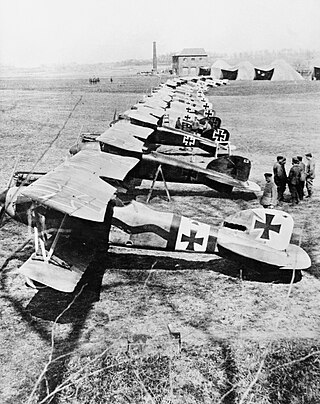
Royal Prussian Jagdstaffel 11 was founded on 28 September 1916 from elements of 4 Armee's “Kampfeinsitzer” or KEKs) 1, 2 and 3 and mobilized on 11 October as part of the German Air Service's expansion program, forming permanent specialised fighter squadrons, or "Jastas". It became the most successful fighter squadron in the Luftstreitkräfte.
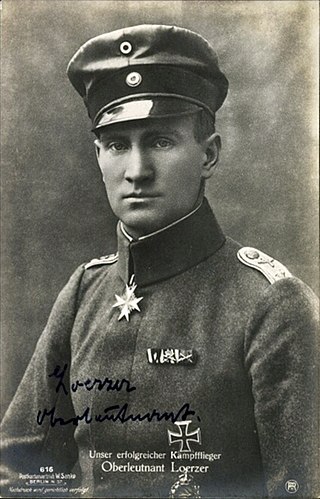
Bruno Loerzer was a German air force officer during World War I and World War II. Credited with 44 aerial victories during World War I, he was one of Germany's leading flying aces, as well as commander of one of the first Imperial German Air Service Jagdeschwaders.

Theodor "Theo" Osterkamp was a German fighter pilot during World War I and World War II. A flying ace, he achieved 32 victories in World War I. In World War II, he led Jagdgeschwader 51 up to the Battle of Britain and claimed a further six victories during World War II, in the process becoming one of only a few men to score victories and become an ace in both world wars.

Anton "Toni" Hackl was a German Luftwaffe military aviator during World War II, a fighter ace credited with 192 enemy aircraft shot down in over 1,000 combat missions. The majority of his victories were claimed over the Eastern Front, with 87 claims over the Western Front. Of his 87 victories over the Western Allies, at least 32 were four-engined bombers, a further 24 victories were unconfirmed.
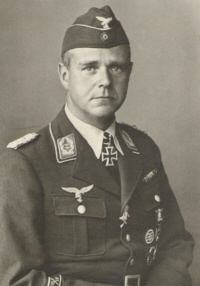
Harry von Bülow-Bothkamp was a German fighter pilot notable for being one of the few two-war aces in history. After scoring six victories in World War I, he became a Luftwaffe ace in World War II, with 12 additional victories. Also he was a member of the National Socialist Flyers Corps with the rank of NSFK-Obergruppenführer.

Jagdgeschwader 4 was a Luftwaffe fighter wing of World War II.

Jagdgeschwader 300 was a Luftwaffe fighter-wing of World War II. JG 300 was formed on June 26, 1943 in Deelen as Stab/Versuchskommando Herrmann, from July 18, 1943 as Stab/JG Herrmann and finally renamed on August 20, 1943 to Stab/JG 300. Its first Geschwaderkommodore was Oberstleutnant Hajo Herrmann.

A Jagdstaffel was a fighter Staffel (squadron) of the German Imperial Luftstreitkräfte during World War I.
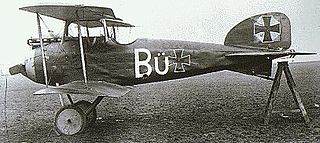
Jasta 2 was one of the best-known German Luftstreitkräfte Squadrons in World War I. Its first commanding officer was the great aerial tactician Oswald Boelcke, and it was the incubator of several notable aviation careers.
Generalmajor Hermann Frommherz Military Order of St. Henry, Royal House Order of Hohenzollern, Knight's Cross of the Military Karl-Friedrich Merit Order, began his military career in World War I as a German ace fighter pilot. He was credited with 32 victories. During World War II he was involved in the German takeover of Czechoslovakia and rose to become a Luftwaffe Generalmajor.
Hans Klein was a German World War I fighter ace credited with 22 aerial victories.
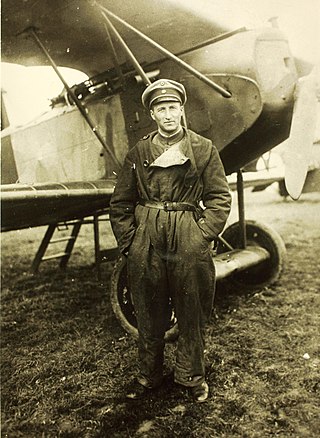
Doctor OberleutnantOtto Schmidt HOH, IC was a German World War I fighter ace credited with 20 aerial victories, including eight against enemy observation balloons. He commanded three different jagdstaffeln (squadrons) as well as a jagdgruppe.

Leutnant Otto Paul Wilhelm Höhne was a German World War I flying ace credited with six confirmed aerial victories. Höhne was a pioneer ace; he was the first pilot to score a victory while flying the Albatros D.1. During World War II he was a recipient of the Knight's Cross of the Iron Cross.
VizefeldwebelGustav Klaudat was a German World War I flying ace credited with six aerial victories.
Vizefeldwebel Willi Gabriel was a World War I flying ace credited with eleven aerial victories. Hermann Göring removed Gabriel from combat duty for shooting four enemy airplanes contrary to orders.
Leutnant Hans Müller, alias Hans Garelt, was a German World War I flying ace credited with twelve aerial victories.
Oberst Paul Aue was a World War I flying ace from the Kingdom of Saxony in the German Empire. Partial records of his early aviation career credit him with 10 aerial victories. He would join the nascent Luftwaffe during the 1930s and serve Germany through World War II. He died in a Russian prison camp in 1945.
Jagdgeschwader II was the Imperial German Air Service's second fighter wing. Established because of the great success of Manfred von Richthofen's preceding Jagdgeschwader I wing, Jagdgeschwader II and Jagdgeschwader III were founded on 2 February 1918. JG II was assigned four squadrons nominally equipped with 14 aircraft each. The new wing was supposed to be fully operational in time for an offensive slated for 21 March 1918. Named to raise and lead it was 23-victory flying ace Hauptmann Adolf von Tutschek. However, he was killed in action on 15 March 1918.
Jagdgeschwader III was a fighter wing of the Imperial German Air Service during World War I. It was founded on 2 February 1918, as a permanent consolidation of four established jagdstaffeln —2, 26, 27, and 36. JG III was formed as a follow-on of Manfred von Richthofen's highly successful Jagdgeschwader I. With a nominal strength of 56 aircraft, JG III would be under direct orders of an Armee headquarters. The German General Staff was planning a German spring offensive to begin on 21 March 1918, and wanted to assign a fighter wing to each of the three Armees involved in the assault. An experienced flying ace with 22 victories, Oberleutnant Bruno Loerzer, was appointed to command JG III.
References
- Mückler, Jörg (November–December 2019). "Au combat dans deux guerres mondiales: l'as Alfred Lindenberger" [In Combat in Two World Wars: The Ace Alfred Lindenberger]. Avions (in French) (232): 4–19. ISSN 1243-8650.
- 479th Fighter Group: ‘Riddle’s Raiders’ (Aviation Elite Units). John Stanaway. Osprey Publishing, 2009. ISBN 1846034205, ISBN 978-1846034206
- Above the Lines: The Aces and Fighter Units of the German Air Service, Naval Air Service and Flanders Marine Corps 1914 - 1918. Norman L. R. Franks, et al. Grub Street, 1993. ISBN 0-948817-73-9, ISBN 978-0-948817-73-1.
- Aces of Jagdgeschwader Nr. III. Greg vanWyngarden. Bloomsbury Publishing, 2016. ISBN 1472808452, ISBN 9781472808455
- Luftwaffe Sturmgruppen (Aviation Elite Units). John Weal. Osprey Publishing, 2005. ISBN 1841769088, ISBN 978-1841769080
- Oswald Boelcke: Germany's First Fighter Ace and Father of Air Combat. R. G. Head. Grub Street, 2016. ISBN 1910690236, ISBN 978-1910690239.